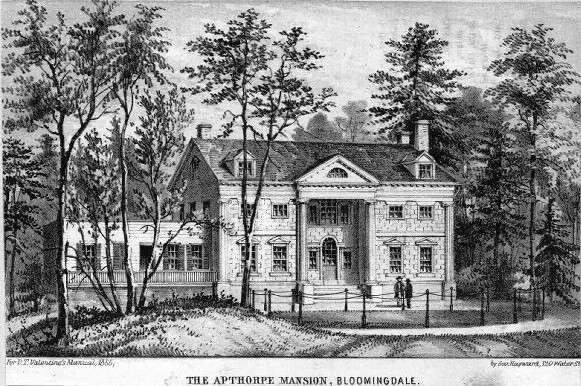 |
| print NYPL Collection |
Thomas Osborne was the Irish-born owner of a successful stone-cutting business on the east side of Manhattan. With a nearly-unlimited supply of stone at cost, construction of a huge, stone apartment building made perfect sense.
For $210,000, Osborne purchased from John Tayolor, a restauranteur, the large lot of land at 57th Street and 7th Avenue. In 1883 the neighborhood still consisted of small commercial buildings and stables. The concept of upper class apartment buildings was in its infancy and he knew he had to pull out all the stops to make his project attractive to wealthy residents.
To design the building that Osborne would name after himself, architect James E. Ware was commissioned. Ware was given the task of producing a building that would attract the affluent New Yorkers who were accustomed to large, refined houses rather than apartment buildings, which were associated with the lower classes.
The architect designed a fortress-like, imposing building by mixing Italian-Renaissance, Romanesque and Renaissance styles. His free-handed handling resulting in a somewhat foreboding and chunky structure on the exterior.
Originally 11 stories on 57th Street and 14 stories to the rear (although, because the front apartments had 15-foot ceilings, the 57th Street elevation was taller),the structure was wrapped by three balustraded cornices at the third, seventh and tenth floors. A deep, arched porch framed the entrance and bay windows from the third through sixth floors gave the façade an interesting, almost undulating appearance.
Lobby clock amid encrusted decoration -- Photo columbia.edu
It was on the interiors, however, that Ware lavished his attention. It was essential that the lobby impress even the most jaded New Yorker. Working with Tiffany Studios, artists J. A. Holzer, Augustus Saint-Gaudens and John LaFarge fashioned mosaics, multi-colored marble, gold leafed details and murals into a palatial common space. Under a coffered ceiling, carved stone niche benches sat on mosaic and inlaid marble floors.
Visitor's waiting bench -- photograph columbia.edu
Osborne’s intention from the beginning was to sell the building rather than to run it and as construction continued he attempted to do so. There were no buyers, however, and the project went forth.
 |
| photograph columbia.edu |
And to keep the tenants fit, an all-weather croquet ground was installed on the roof to permit year-round exercise. For residents’ convenience the basement level was to house a florist, doctor and pharmacy.
The Osborne Flats was completed in 1885, two years after ground breaking. The $1,209,00 cost drove Osborn into bankruptcy and, ironically, the building was sold to John Taylor who had originally owned the land. Taylor’s estate lost the building to foreclosure in 1888 when it was purchased by William Taylor, another relative, for $1,009,250 -- $200,000 less than the cost of construction.
In 1889 Ware was called back to add another story to the rear, leveling the roofline. Only seven years later the demand for more space in The Osborne necessitated architect Alfred S. G. Taylor to add a 25-foot extension to the west side. Taylor (also a relative of John Taylor and a part-owner of the building) was sympathetic to the original Ware designs so that his addition is nearly unnoticeable.
 |
| The Osborne Flats 1915 - NYPL Collection |
Despite the financial problems, Thomas Osborne’s vision of a residence for the elite came true. Throughout its history The Osborne housed both the rich and famous. United States Senator John Coit Spooner was an early resident and Philip T. Dodge was living here in 1928 when he married Lilias Sutherland, 20 years his junior. Entertainers Vera Miles, Imogene Coca, Lynn Redgrave, Clifton Webb, humorist Fran Lebowitz, Andre Watts and fashion designer Fernando Sanchez all called The Osborne home. The list is seemingly endless.
As a strange historical footnote, The Euthanasia Society of America held its meetings there in the home of Mrs. Joseph M. Proskauer, a director of the society in the 1950s.
In 1961 the Taylor family sold The Osborne to a developer with plans to replace the building with a high rise apartment building. The residents revolted. Forming a cooperative, they save the building by purchasing it for $2.5 million. Commenting on the rescue, The New York Times said “Where else but at the Osborne apartment house could you open one closet and hear Blanche Thebom vocalizing and another and listen to Van Cliburn practicing.”
That year Leonard Bernstein purchased apartment 4B, later to be sold to actor Larry Storch, who sold it to entertainer Bobby Short in 1970. Tragedy struck when on October 19, 1978 police arrived at the apartment of actor Gig Young. Young had shot to death his wife of three weeks, Kim Schmidt, then turned the gun on himself.
In 1988 Robert Osborne, the host of Turner Classic Movies was looking for an apartment in Manhattan. Carol Burnett told him of an apartment in the Osborne being sold by a friend. Osborne toured with apartment with Bette Davis before purchased it – the first of his three apartments he owns there.
Throughout the 20th Century about half of the apartments were divided into smaller spaces; however many of them retain their original grandeur. Referred to by the AIA Guide to New York City as “The dour matriarch of 57th Street,” The Osborne was granted landmark status in 1991.














































